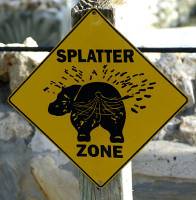Summary
Students will investigate the nitrogen cycle and the flow of nutrients in an ecosystem.
Essential Question(s)
How does nature recycle?
Snapshot
Engage
Students watch a video clip and brainstorm fish tank care.
Explore
Students use ammonia test kits to determine the level of ammonia in the three water samples, then design and test an experiment to determine which water source contains the highest level of ammonia.
Explain
Students share their data from the experiment, then examine the nitrogen cycle and utilize it to better explain why some water samples have more ammonia than others.
Extend
Students analyze the nitrogen cycle in more detail and identify components of an ongoing experiment about nitrogen fixation.
Evaluate
Students analyze the impact of whale feces and hippo feces in certain ecosystems and take an in-depth look at microorganisms. The lesson ends with students authoring a children's book about food webs and the nitrogen cycle.
Materials
Ammonia testing strips--these can be found in pet stores or the pet section of most major department stores.
Spring water sample for all groups in all classes
River or stream water sample for all groups in all classes
Livestock pond water sample for all groups in all classes
Small cups for distributing water to groups
Colored pencils/markers/crayons for the Frayer Model and children's book
Computer with internet access, a projector, and speakers
1 ream of 8.5 x 11 copier paper (this is enough for all classes)
Computers to research for children's book (optional)
Engage
Play the video of Nemo getting clogged the filter in Finding Nemo.
Begin this lesson by asking students to think about the two most important aspects of caring for a fish, even if they've never owned a fish personally. Give students a minute or two to think, then ask students to share their answers with the class.
Finish with the question: "Do you think ammonia is present in water sources other than fish tanks?" Allow a few options, then move on.
Explore
Tell students they are now going to plan an experiment to test nitrogen levels in water from a spring, a river, or stream and a pond location.
Place students into groups of four.
Show the students how the test strips work because they will need to include how to test the water in their lab protocol.
Give students handout "1_Experimental Design." This handout will guide their experimental design. See Attachments for both student and teacher copies of this handout.
Students need to come up with a plan as a group, then write up their experiment. This can be turned in at the end of the lab and used for evaluation purposes if you need more assessments.
Explain
Once students complete their experiment, pass out the document titled 'Nitrogen Explain' and have students answer the questions in their lab group.
Extend
In their lab groups still, pass out one article to each group. Have them read the article together, and decide what is most informative. Then, tell students that they are going to create a Two-Minute Documentary over their article to present to the class. Encourage them to use props if they feel like it's needed.
Evaluate
Have students complete a Frayer Model over the nitrogen cycle. When they are done have the students turn it in as a grade.
Resources
Fish tank cleaning video (from Engage): https://www.youtube.com/watch?v=z8BsjRruEEM
Ammonia in fish tank (from Engage): http://www.koivet.com/a_ammonia.html
Phytoplankton and nitrogen fixation by cyanobacteria: http://www.soes.soton.ac.uk/staff/tt/nf/structure/
Land Nitrogen Fixation Video Link: https://www.youtube.com/watch?v=4NKGS4bj7cc
Marine Nitrogen Fixation Link: https://www.youtube.com/watch?v=9eEpgSvnMrA
Nasa website where phytoplankton article came from: http://earthobservatory.nasa.gov/Features/Phytoplankton/printall.php


